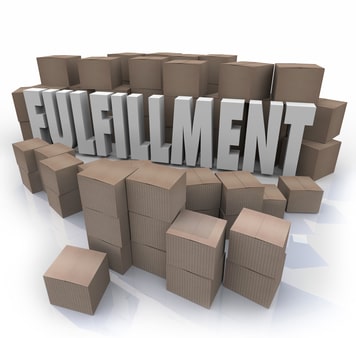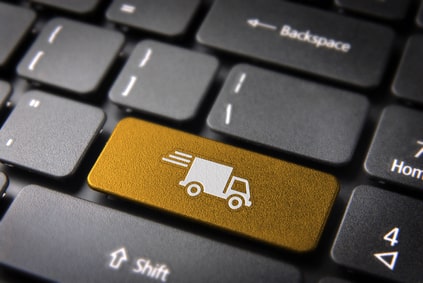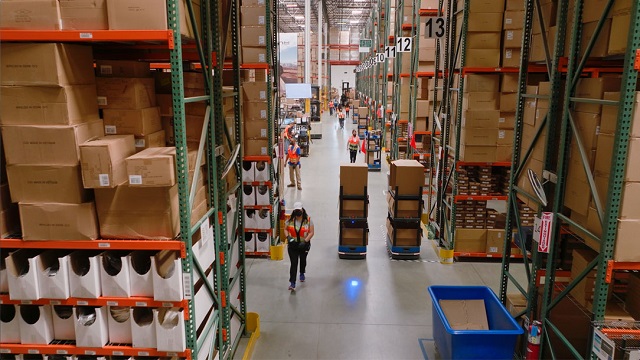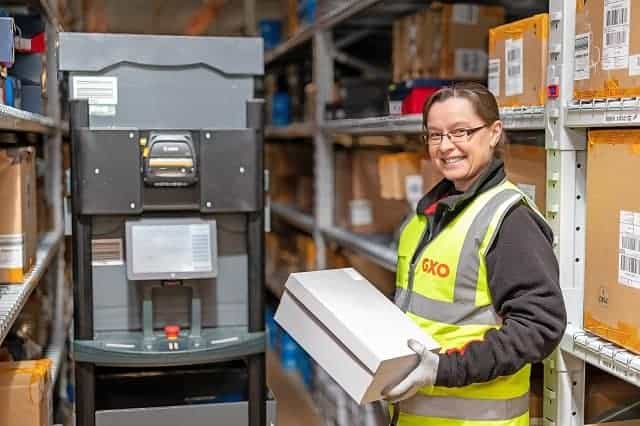What is order fulfillment in supply chain management? It is the process of receiving goods, then processing and delivering orders to customers.
The order fulfillment process starts with a customer placing an order and ends once they receive it. However, if the buyer wants to return a product, order fulfillment manages the return transaction as well.
Here’s a list of the five steps in the order fulfillment process:
- Receiving inventory shipments
- Inventory storage
- Order processing
- Shipping
- Returns processing
Order fulfillment can be an expensive and complex process. Some companies handle order fulfillment in-house, while others outsource the process to a third-party logistics company or 3PL.
Let’s take a closer look at the benefits and challenges associated with order fulfillment.
What are 4 types of order fulfillment?

Order fulfillment is one component of the broader supply chain process.
There are four main types of order fulfillment:
- In-house fulfillment
- Outsourced fulfillment
- Dropshipping
- Hybrid fulfillment
1. In-House Order Fulfillment
In the in-house order fulfillment model, a business uses its own employees to manage fulfillment processes. Employees handle all steps of the fulfillment process, including storing and shipping the products on-site at a company-controlled location. In-house fulfillment is ideal for established companies that want to have end-to-end control over the entire operation.
Some home-based startups start out using in-house fulfillment as a low-cost option, particularly those with small order volumes. As they outgrow their initial space, many move to outsourced or hybrid fulfillment models.
2. Outsourced Order Fulfillment
Outsourced order fulfillment is when shipping, storing and order/refund processing is handled by a third-party logistics (3PL) or order fulfillment company. Companies that don’t have sufficient storage space or personnel may choose this option.
In this case, the 3PL’s employees handle the entire fulfillment process from end-to-end, from receiving inventory from manufacturers to delivering orders to the end customer. Inventory is stored in a warehouse controlled by the 3PL, meaning companies that use outsourced fulfillment don’t need to invest in their own warehouse facilities.
3. Dropshipping
Dropshipping is similar to outsourcing, except there’s no inventory to manage. The retailer doesn’t keep the items it sells in stock. Instead, when an item is sold, the retailer purchases it from a third-party supplier.
The supplier may be a manufacturer or a company that procures products from manufacturers to sell to dropshippers. The supplier handles all orders and ships them to your customers. You’re only billed for the products you sell.
It’s common for e-commerce and startup retailers to use this option.
4. Hybrid Fulfillment
A company that uses a mix of the above order fulfillment options is using a hybrid fulfillment model. For instance, a company may process some orders in-house, such as custom items or items that must be assembled before shipping, while also using dropshipping services for non-custom items.
Some companies choose to use dropshipping for items that are infrequently purchased or those that they don’t want to store in-house, such as large or expensive items. This is ideal for companies that need more flexibility or are undergoing rapid expansion.
Why is order fulfillment important?

Today’s consumers are used to two-day (or even next-day) shipping options. So, the demand is high for shipments that are fast and on-time. When your order fulfillment process isn’t consistent or timely, you may struggle with getting shipments delivered on time, which can hurt your business (and bottom line).
Just look at the stats — 43% of customers say they won’t shop with a retailer again for at least a month after a negative delivery experience. Another 38% of customers say they won’t shop with retailers again at all.
Order fulfillment options have a direct impact on a customer’s buying habits. Customers want delivery options that best suit their needs. Offering a mix of fast and moderate shipping options allows consumers to choose based on their budget and time constraints.
Companies that don’t offer desirable options risk losing business before customers even give them a chance: 45% of customers say they’ve abandoned a cart due to poor delivery options, and 58% of consumers say they’ve purchased from one company over another because they offered more delivery options.
The competitive advantage of a quick and efficient order fulfillment process:
If you want to gain a competitive advantage, then it’s crucial to deliver on customer expectations for quick delivery and prompt return services. By optimizing your order fulfillment processes, you can:
- Lower your costs for shipping
- Reduce operational costs
- Expand your customer base (globally)
- Enhance customer service
- Focus on selling
The 4 biggest challenges of order fulfillment
It’s not always easy to implement effective order fulfillment processes. Businesses face complex challenges with demand, inventory management and warehouse logistics planning.
Here’s a breakdown of the most common challenges companies face with the order fulfillment process:
- Inventory management: Running out of stock is a quick way to deter customers from shopping with you. Companies that succeed in maintaining optimal inventory levels won’t have to worry about losing customers to their competitors due to stockouts.
- Demand planning: It’s critical to know the demand for the products you sell. This way, you won’t risk overstocking (which can be just as costly as understocking). Demand shaping can also help with this, which involves using marketing and promotions to create demand.
- Logistics planning: The shipping process is just as important as the sale itself, if not more so. You need to ensure the shipping methods, speed and care taken to get products to your customers. Otherwise, you risk late, broken or missing packages, which can hurt your reputation and sales.
- Supply chain execution: Despite even the best planning, running out of inventory happens, especially during unexpected spikes in demand. When demand depletes your inventories, you must be able to replenish those items as quickly as possible. Choosing manufacturers that can quickly fulfill your own orders is vital.
Order fulfillment: 4 best practices to optimize and improve your process

Creating a streamlined order fulfillment process is the key to winning over customers and maintaining your competitive edge. There are several best practices to keep in mind that can help you optimize your order fulfillment processes.
- Choose what will work best for you: First, you need to use the fulfillment model that best suits your business. It should be flexible enough to handle your order volumes, customer locations and sales channels. If you sell customized or made-to-order products, then your fulfillment process must be able to accommodate those complexities without adding unnecessary delays.
- Use data to drive your decisions: Your technology should support order fulfillment with real-time data, giving you inventory visibility and enabling more accurate demand predictions. Making data-driven decisions about purchasing and production makes it easier to keep up with demand and maintain optimized inventory levels.
- Communicate clearly and effectively: With better supply chain visibility, you can set clear expectations with customers about deliveries. Be transparent about returns processes, as well.
- Embrace automation: Finally, leverage warehouse automation to improve order fulfillment efficiency and accuracy to better meet your customers’ expectations. Flexible automation solutions like collaborative mobile robots optimize order picking routes in real-time, reducing unnecessary walking and improving picking efficiency. Collaborative mobile robots leverage AI and machine learning, guiding warehouse associates through tasks to help them work faster while reducing errors.
Final Thoughts on Order Fulfillment
There’s no single fulfillment process that works for every business. Whether you choose to outsource to a third-party logistics company or use a hybrid warehouse fulfillment model, what matters is finding the right process that meets your company’s needs and your customers’ expectations.
The goal is to streamline your fulfillment processes so your customers stay happy and your bottom line doesn’t suffer.
Interested in more? Let’s discuss the solution that’s right for you. Contact us today.


